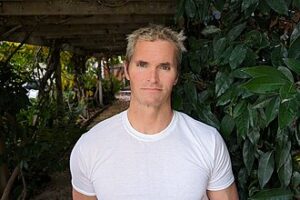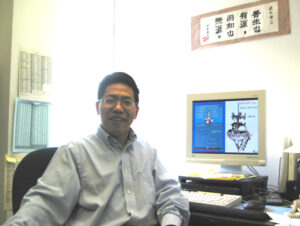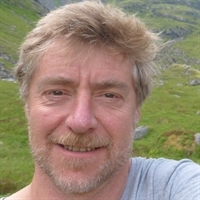The Amazon – lungs of the world – is in last-stage crisis. It is boiling in record smashing heat, drought, and fire. We visit the last stand with Rhett Butler, Founder and CEO of independent media hub Mongabay. Does it seem more stormy where you live? Senior scientist Aiguo Dai confirms the atmosphere has been destabilized and is expected to get more wild as warming continues. I repeat: the atmosphere is destabilized. The show wraps with Dr. Douglas Sheil in Norway: can trees make their own weather?
I’m Alex Smith. Welcome to Radio Ecoshock.
Listen to or download this Radio Ecoshock show in CD Quality (57MB or Lo-Fi (14 MB)
RHETT BUTLER – AMAZON HEAT
The Amazon – “lungs of the planet” – are baking with extended record heat. Wet rainforests are drying out. Rivers are the highways and lifeblood of the Amazon people, but now rivers shrunk to small streams of toxic water. This is a big barely reported emergency.

The very best reporting comes through the award-winning non-profit media group Mongabay. The Founder and CEO is Rhett Butler. Rhett started out on his own, posting thousands of environmental articles and photos. Now Mongabay has more than 90 staff across five bureaus and a network of about 1,000 correspondents in 80 countries.
Listen to or download this 28 minute interview with Rhett Butler in CD Quality or Lo-Fi
COOKING THE AMAZON – AMAZING HEAT
According to Al Jazerra, quote “Nine heatwaves have hit Brazil since the beginning of [2023], with the heat index in Rio de Janeiro soaring to almost 60 degrees Celsius (140 degrees Fahrenheit) in November.”
Maximiliano Herrera is a climatologist and weather historian. In early January he said:
“Next days South America will witness a terrible heat wave with temperatures up to 45C,nights well over 30C and high humidity. ThIs will be locally among the worst heat indexes ever recorded in the Southern Hemisphere.”
According to long-time Amazon watcher Philip Fearnside, the city of Manaus has “The lowest water levels in 121 years of river-level records.” Amazonians are at a loss. Important food fish are gone. Remaining river water makes anyone sick. The stunning thing is: consumer economies far away in the North did this. We burned the fossil fuels and stripped life until the overheated drought arrived in the Amazon.
There is some good news. A post January 8th at Yale 360 says: “Forest loss in the Brazilian Amazon was down 50 percent, year on year, in 2023, according to government figures.” The drop comes with the return of a President committed to saving the Amazon. Is it enough to counterbalance climate-driven changes? Apparently not. Remember when “deforestation rates” go down, deforestration is still happening. We are losing more and more of the Amazon but more slowly for a while…
The European Joint Research Centre published a study in December, titled: “Drought in the Amazon basin November 2023.” They also point to El Nino as a driver of warmer and drier times there. I ask Rhett: How do we balance El Nino and climate change in this Amazon emergency?
Also amazing Amazon news, a paper in science “Discovered in the Upper Amazon: 2500-year-old landscape providing evidence for early urbanism in the region.” They found 6000 platforms and plaza structures connected by footpaths, straight roads, and extensive agriculture. All this in the Ecuadorian Amazon starting at the time of Homer and the Ancient Greeks. Isn’t that exciting? But it also says: we do not know what we are destroying.
FREE FROM MONGABAY
Mongabay publishing the new edition of the book “A Perfect Storm in the Amazon” .
Mongabay just published a story about the increase in deforestation in Indonesia by the pulp and paper industry, despite big producers like APRIL and APP committing to “zero deforestation”. If this continues to escalate – what is at stake? – and are the Indonesian government or the companies likely to do anything to reverse this trend? I ask Rhett in the interview.
RHETT’S SCIENCE
Rhett Butler is a powerhouse hub of information of the wild. He also co-founded the journal “Tropical Conservation Science”. In 2023 Butler co-authored the paper “Broadening the focus of forest conservation beyond carbon.”
====================================
DESTABILIZED ATMOSPHERE – AIGUO DAI
Does the weather seem strange lately? Many places suffer storm after storm with freak extremes like high river flooding in winter when it should all be frozen, or tornados where tornados are not a thing. If it feels different than when you were a kid, you are not imagining it.
Watching network news, we find storm after storm going coast to coast across the United States. New Englanders have to duck every week and the south gets violent storms and tornados. The UK and Ireland have been stormy with flooding. Is the weather different than it was before?
In the journal Geophysical Research Letters we find recent confirmation with this paper: “The Atmosphere Has Become Increasingly Unstable During 1979–2020 Over the Northern Hemisphere”. Here to explain is co-author Dr. Aiguo Dai. He is Distinguished Professor in the Department of Atmospheric & Environmental Sciences at the University of Albany. Dr. Dai is well-known in his field with over 200 peer-reviewed papers.

Listen to or download this 20 minute interview with Aiguo Dai in CD Quality or Lo-Fi
Watching network news, we find storm after storm going coast to coast across the United States. New Englanders have to duck every week and the south gets violent storms and tornados. The UK and Ireland have been stormy with flooding. Is the weather different than it was before? Dr. Dai tracked weather data across time finding more extreme weather in the last decade than in the period beginning in 1979.
This paper only reports on instability in the Northern Hemisphere. Dr. Dai tells us this is because most of the Southern Hemisphere is ocean. There are no weather stations releasing balloons in the open ocean – so there is not enough data to develop a similar study of atmospheric instability in that Hemisphere.
Near the end of the interview I also ask about Dr. Dai’s world drought forecast posted on YouTube. It’s just a short video-only mapping of where drought appears as this century progresses – and where it gets wetter. It is simple and thought-provoking.
Video of “Drought Potential in the 21st Century” posted by NCAR VisLab. (no audio)
In his YouTube explainer of the destabized atmosphere paper Canadian climate scientist writes:
“Basically, periods of time when the atmosphere are unstable has increased by between 2% and 8% per decade, for each of the last four decades, for a total increase of between 8% and 32% depending on the location…Not only do we have slowing meandering jet streams becoming much wavier leading to much worse extreme weather events, the actual atmosphere itself is much more unstable and prone to much more intense, much higher frequency, and much longer duration storms.”
OTHER RECENT PAPERS by AIGUO DAI MENTIONED IN THIS INTERVIEW
In the last couple of months, two of Dai’s recent co-authored papers concerned impacts of Arctic sea-ice loss – for both Siberian wildfires and clouds above the Arctic. “Rapid summer Russian Arctic sea-ice loss enhances the risk of recent Eastern Siberian wildfires”
AND
“Seasonal Variations and Spatial Patterns of Arctic Cloud Changes in Association with Sea Ice Loss during 1950–2019 in ERA5”Matthew T. Jenkins, Aiguo Dai, and Clara Deser
Online Publication: 29 Dec 2023
=========================================
DOUGLAS SHEIL – TREE WEATHER
As humans make roads, burn, and slash the Amazon, global warming ramps up the risk of losing vast rainforests loaded with unseen creatures and a rich ark of plants. Even the rainforest retreat can change local conditions from lush wet growth to drought and fire.
Scientists are still asking: can trees make their own weather? We know the Amazon evaporates water leading to local clouds with rain. Big trees also release micro-particles which can form rain nuclei. That still leaves a problem. Unlike the dry inland great plains East of the Rocky Mountains, there are wet forests East of the Andes mountains. Why? Most clouds pick up moisture from the ocean. Some scientists suggest forests can pass rain clouds inland from the sea.

In the show you hear a selection from my 2017 interview with Dr. Douglas Sheil then at the Norwegian University of Life Sciences. Dr. Sheil has since been appointed Professor of Forest Ecology and Management at Wageningen University in the Netherlands.
Listen to or download the full 28 minute interview with Douglas Sheil in CD Quality or Lo-Fi
We are totally out of time. I’m Alex Smith. Thank you for reading and listening – and caring about our world.